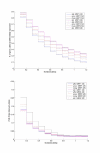Comparison of hybridization-based and sequencing-based gene expression technologies on biological replicates
- PMID: 17555589
- PMCID: PMC1899500
- DOI: 10.1186/1471-2164-8-153
Comparison of hybridization-based and sequencing-based gene expression technologies on biological replicates
Abstract
Background: High-throughput systems for gene expression profiling have been developed and have matured rapidly through the past decade. Broadly, these can be divided into two categories: hybridization-based and sequencing-based approaches. With data from different technologies being accumulated, concerns and challenges are raised about the level of agreement across technologies. As part of an ongoing large-scale cross-platform data comparison framework, we report here a comparison based on identical samples between one-dye DNA microarray platforms and MPSS (Massively Parallel Signature Sequencing).
Results: The DNA microarray platforms generally provided highly correlated data, while moderate correlations between microarrays and MPSS were obtained. Disagreements between the two types of technologies can be attributed to limitations inherent to both technologies. The variation found between pooled biological replicates underlines the importance of exercising caution in identification of differential expression, especially for the purposes of biomarker discovery.
Conclusion: Based on different principles, hybridization-based and sequencing-based technologies should be considered complementary to each other, rather than competitive alternatives for measuring gene expression, and currently, both are important tools for transcriptome profiling.
Figures




Similar articles
-
A comparison of microarray and MPSS technology platforms for expression analysis of Arabidopsis.BMC Genomics. 2007 Nov 12;8:414. doi: 10.1186/1471-2164-8-414. BMC Genomics. 2007. PMID: 17997849 Free PMC article.
-
Large scale real-time PCR validation on gene expression measurements from two commercial long-oligonucleotide microarrays.BMC Genomics. 2006 Mar 21;7:59. doi: 10.1186/1471-2164-7-59. BMC Genomics. 2006. PMID: 16551369 Free PMC article.
-
A study of inter-lab and inter-platform agreement of DNA microarray data.BMC Genomics. 2005 May 11;6:71. doi: 10.1186/1471-2164-6-71. BMC Genomics. 2005. PMID: 15888200 Free PMC article.
-
Principles of gene microarray data analysis.Adv Exp Med Biol. 2007;593:19-30. doi: 10.1007/978-0-387-39978-2_3. Adv Exp Med Biol. 2007. PMID: 17265713 Review.
-
Massively parallel signature sequencing (MPSS) as a tool for in-depth quantitative gene expression profiling in all organisms.Brief Funct Genomic Proteomic. 2002 Feb;1(1):95-104. doi: 10.1093/bfgp/1.1.95. Brief Funct Genomic Proteomic. 2002. PMID: 15251069 Review.
Cited by
-
A comparison of microarray and MPSS technology platforms for expression analysis of Arabidopsis.BMC Genomics. 2007 Nov 12;8:414. doi: 10.1186/1471-2164-8-414. BMC Genomics. 2007. PMID: 17997849 Free PMC article.
-
In plants, expression breadth and expression level distinctly and non-linearly correlate with gene structure.Biol Direct. 2009 Nov 21;4:45; discussion 45. doi: 10.1186/1745-6150-4-45. Biol Direct. 2009. PMID: 19930585 Free PMC article.
-
Quantitative methods for genome-scale analysis of in situ hybridization and correlation with microarray data.Genome Biol. 2008 Jan 30;9(1):R23. doi: 10.1186/gb-2008-9-1-r23. Genome Biol. 2008. PMID: 18234097 Free PMC article.
-
Gene network and canonical pathway analysis in prostate cancer: a microarray study.Exp Mol Med. 2008 Apr 30;40(2):176-85. doi: 10.3858/emm.2008.40.2.176. Exp Mol Med. 2008. PMID: 18446056 Free PMC article.
-
Validation of oligoarrays for quantitative exploration of the transcriptome.BMC Genomics. 2008 May 30;9:258. doi: 10.1186/1471-2164-9-258. BMC Genomics. 2008. PMID: 18513391 Free PMC article.
References
-
- Brenner S, Johnson M, Bridgham J, Golda G, Lloyd DH, Johnson D, Luo S, McCurdy S, Foy M, Ewan M, Roth R, George D, Eletr S, Albrecht G, Vermaas E, Williams SR, Moon K, Burcham T, Pallas M, DuBridge RB, Kirchner J, Fearon K, Mao J, Corcoran K. Gene expression analysis by massively parallel signature sequencing (MPSS) on microbead arrays. Nat Biotechnol. 2000;18:630–634. doi: 10.1038/76469. - DOI - PubMed
Publication types
MeSH terms
Associated data
- Actions
Grants and funding
LinkOut - more resources
Full Text Sources
Molecular Biology Databases
Research Materials
Miscellaneous

